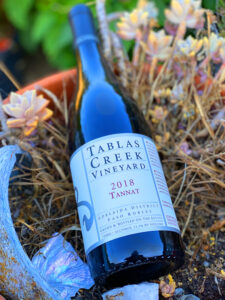2018 Tablas Creek Vineyard, Tannat, Adelaida District, Paso Robles.
The beautifully dark and blue fruited Tablas Creek 2018 Tannat is Tablas Creek’s seventeenth bottling of this traditional Basque grape from South-West France and one of the best I’ve tried with deep layers and fresh details from this remarkable vintage that gave beautiful fruit concentration, lively acidity and heightened aromatics, making this wine exceptionally delicious. With a reputation of being a rough and tumble grape, Tablas’ version is impeccably charming, while retaining the firm, Cabernet like, framework and varietal markers that make Tannat what it is, it shows a fine balance of fruit and savory elements with blackberry, blueberry and tangy wild plum leading the way on the full bodied palate along with hints of dried lilacs, Turkish fig, dusty spices, anise and cedar notes. Built to survive a few decades, the Tablas Tannat is drinking fabulous in its youth, adding a bit of mineral, saline, bitter coco and menthol, all of which brings memories of some of my favorite Iroulèguy wines, like those of Domaine Ilarria, imported by Charles Neal Selections. The Tannat grapes were 100% de-stemmed and fermented using native yeasts. As Tablas notes, as they have for many years, they blended in a tiny of Cabernet Sauvignon, making the final wine a 97% Tannat and 3% Cabernet blend. It then aged it in one large foudre and a mix of new and older smaller French oak barrels for close to 24 months before bottling, after which it was rested in the bottle for more than 6 months prior to its release. Tablas Creek, known for bringing those Chateauneuf du Pape grapes over, also brought Tannat cuttings, and we are all the better for it.
Tannat, originally from the southwest of France, is mainly found near the French Pyrénées and French Basque country and is a powerful dark skinned varietal that has found a welcoming home here in California, as well as in Uruguay, where it is celebrated as their national grape. The wine made from Tannat is notable for its very high tannin levels and is often blended with Cabernet Sauvignon, Malbec and Cabernet Franc and found most notably in the Madiran AOC, though almost quite famously Tannat is also produced in Irouléguy, and it can also be used as a minor grape in the mostly Malbec wines of Cahors. Tannat known for its earthy rustic character and fiery tannins and is best served with robust cuisine choices, while the French versions remain a bit chewy and full of grip, the grape here in California has largely been tamed from giving a harsh performance, while still being dense, meaty and structured, making it very compelling on its own, but also great in blends. Interesting, the grape has brought out innovation in winemaking techniques, as witnessed back in 1990, when Madiran winemaker Patrick Ducournau experimented with adding controlled amounts of oxygen aeration into Tannat while fermenting it, to achieve softer results, and ended up developing the modern winemaking process of micro-oxygenation! Those that love the modern versions of Paso red blends will now find many contain small portions of Tannat, and they are the better for it, and this almost solo effort is a great way to discover this grape, though as mentioned I’d be sure to have a hearty meal with it, in particular a rack of lamb, wild mushroom dishes and or hard sheep’s cheese.
($40 Est.) 92 Points, grapelive
